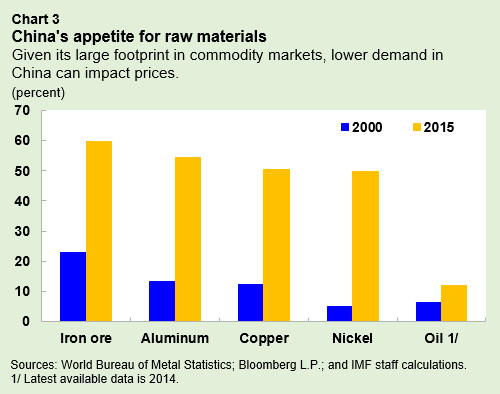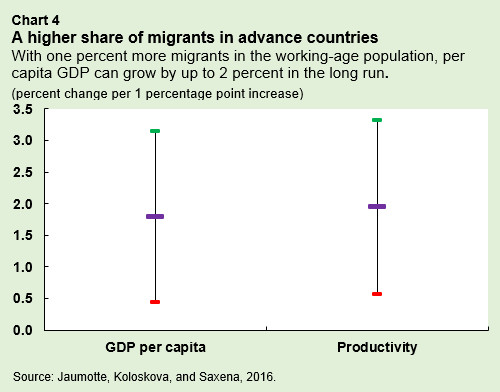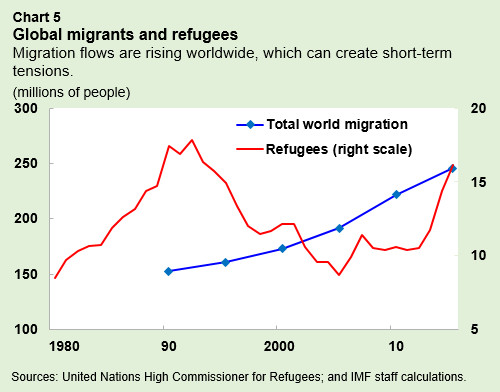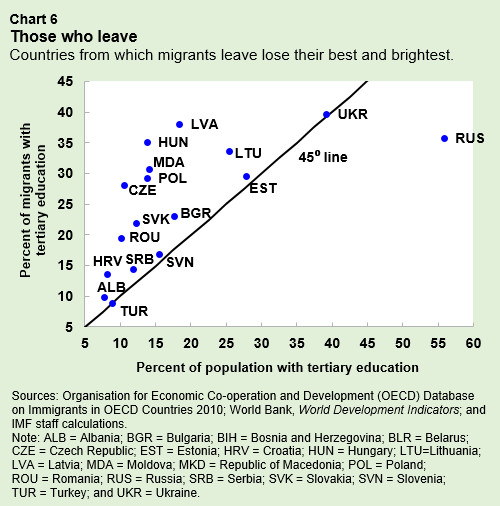
Refugees and migrants at the closed gate of a migrant camp in Greece. Quick migrant integration would benefit host country economies (photo: InTime/Reuters/Newscom)
Spillovers from Migration and China's Transition
September 27, 2016
- New IMF spillover analysis looks into China’s transition and international migration
- Despite challenges, China’s transition and migration can have positive long-run effects if managed well
- Key finding: 1 percent increase in migrant share in adult population results in 2 percent higher GDP in the long run
China’s economic transition and the population changes caused by migration are two phenomena originating in emerging economies with spillovers that influence a whole range of other economies. Such spillovers pose short-term challenges, but can be harnessed to benefit the global economy in the long run, IMF economists say in a new study .
Related Links
A smooth transition in China can benefit global economy
Just as rapid growth in China fostered global growth in the past, the ongoing slowdown and rebalancing toward domestic consumption now also has an impact primarily through three channels. First, through trade (see Charts 1, 2): countries that export machinery and raw materials to China see appetite for their products and commodities fall—this hits Asian suppliers particularly hard. Second, through commodity prices (see Chart 3): due to the country’s large share of global consumption of metals and oil, lower demand can reduce prices. Third, through financial channels: the reaction of asset prices in other countries to events in China can amplify spillovers.



A well-managed Chinese transition to lower but more sustainable growth now would reduce risks of a more disruptive adjustment later. In contrast, a bumpy or incomplete transition can exacerbate negative ripple effects.
China can help by accepting the slowdown and communicating policy intentions clearly. Its trade partners need to adjust to a permanently lower Chinese demand but also to use their available resources for tweaking their growth models. Trade could be encouraged by new global and regional agreements, too. Commodity exporters, for their part, should use buffers where available, but they should also rearrange their economic plans toward new revenue sources. Certain low-wage, labor-rich countries can benefit from China’s move up on the production value chain by taking up the Chinese baton. At the global level, protectionism should be avoided, as it will be detrimental to trade over the long term.
Quick migrant integration is key in host countries
On migration, the study finds that a one percentage point increase in the share of migrants in the adult population could increase the GDP per capita in host countries by about 2 percent in the long run (see Chart 4). It also notes that while high-skilled migrants contribute positively to host economies, lower skilled migrant workers, too, can help raise productivity growth by, for example, allowing high-skilled local women go back to, or spend more time, at work. In the long run, host economies can benefit from migration from both high- and low-skilled workers, concludes the study.

However, migration presents challenges in both the countries of origin and the host countries (see Chart 5).

In the countries of origin, the departure of the young and the educated for better economic opportunities can take a toll on long term-growth. The loss of human capital translates into lower productivity, a worsening of skill composition, and dampened tax revenue (see Chart 6). Some of these losses can be mitigated through use of remittances and the use of diaspora networks—but eventually they should tackle the trigger that set their population in motion.

In host countries, arrivals can provoke social tensions, security concerns, even a political backlash. Yet, as the study shows, migration can also offer economic gains in terms of higher growth and productivity. In addition, migrants—predominantly of working age—can offer some relief for an aging population.
Swift labor market integration, however, is key. Here, improved labor market policies, access to education, and support to migrant enterprises can help. While costly in the short run, adding to fiscal pressure in the host countries, these policies allow migrants to obtain and keep a job, and increasingly contribute to the fiscal accounts. And with better social integration, tensions with mainstream society can dwindle.
Labor market integration is a complex task due to language barriers and lack of recognition of work experience and skills, but the study notes that migrants do not affect labor conditions of native workers significantly. In the long term, they increase labor productivity, which, in turn, raises income levels for all.


